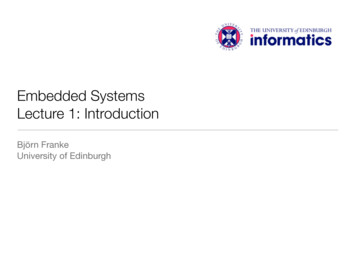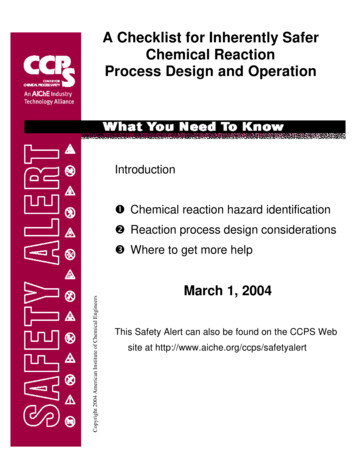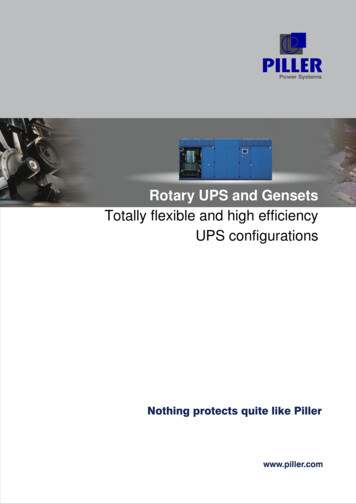
Transcription
Embedded SystemsEmbedded Systems Bernd Finkbeiner (finkbeiner@cs.uni-saarland.de)Rüdiger Ehlers (ehlers@cs.uni-saarland.de)Markus Rabe (rabe@cs.uni-saarland.de)Sebastian Hahn Stammvorlesung 9 CP Lectures: Tuesdays 14:15 – 15:45 Thursdays 16:15 – 17:45 Tutorial time/place to be determined vote for best time on doodle poll webpageBF - ES- 2-1
Textbooks Edward A. Lee and Sanjit A. Seshia,Introduction to Embedded Systems,A Cyber-Physical Approach, 2011.Available online from leeseshia.org Peter Marwedel,Embedded System Design.Springer, Berlin; 2nd Edition, 2011. Giorgio C. ButtazzoHard Real-Time Computing Systems:Predictable Scheduling Algorithms andApplications, Springer, 2011BF - ES- 3-Problem Sets Website: -12/ Problem sets released every Thursday (first on April 19) Due next Wednesday afternoon (postbox),work in groups of three students Weekly discussion sessions (15 minutes each) Individual feedback:mandatory discussion slot per group Format: 15 minutes, slots on Thursday and Friday No grading / solutions only presented in tutorialsBF - ES- 4-2
Exam Policy Qualification: Miss at most two discussion slots & handin solutions to all problem sets Three exams: Midterm/End-of-Term Exam/End-ofSemester Exam Need to pass 2 out of 3 to pass the course Grading: average of best 2BF - ES- 5-Embedded SystemsComputers whose job is notprimarily informationprocessing, but rather isinteracting with physicalprocesses.A broader view is that of cyberphysical systems (CPS)Estimates for number of embedded systemsin current use: 1010[Rammig 2000, Motorola 2001]BF - ES- 6-3
400 horses100 microprocessorsBF - ES- 7-BF - ESStanford, IEEE Spectrum- 8-4
BF - ES- 9-Example: Toyota autonomous vehicle technologyroadmap, c. 2007Source: Toyota Web siteBF - ES- 10 -5
PATHprojectdevelopment effort- 11 4billionBF - ESBF - ESThanks to PATH publication unit- 12 -6
BF - ESYoutube: Manufacturing Robots Automated Assembly- 13 -Printing Press High-speed, high precision Speed: 1 inch/msPrecision: 0.01 inch- Time accuracy: 10us Open standards (Ethernet) Synchronous, Time-TriggeredIEEE 1588 time-sync protocol Application aspectsBosch-RexrothBF - ES local (control)distributed (coordination)global (modes)- 14 -7
BF - ESBF - ying-paster-works.htmlThe DLR hearthttp://www.dualis-medtech.com- 15 -- 16 -8
Mars, July 4, 1997BF - ES- 17 -The MARS Pathfinder problem“But a few days into the mission, not longafter Pathfinder started gatheringmeteorological data, the spacecraftbegan experiencing total system resets,each resulting in losses of data. Thepress reported these failures in termssuch as "software glitches" and "thecomputer was trying to do too manythings at once".” BF - ES- 18 -9
The MARS Pathfinder problem System overview: Information Bus (IB): Buffer for exchanging data between different tasks Shared resource of two tasks M and B Three tasks: Meteorological data gathering task (M):– collects meteorological data– reserves IB, writes data to IB, releases IB– infrequent task, low priority Bus management (B):– data transport from IB to destination– reserves IB, data transport, releases IB– frequent task, high priorityBF - ES- 19 -The MARS Pathfinder problem Three tasks: . “Communication task” (C):– medium priority, does not use IB Scheduling with fixed priorities. Watch dog timer (W): Execution of B as indicator of system hang-up If B is not activated for certain amount of time: Reset thesystemBF - ES- 20 -10
The MARS Pathfinder problem(see http://research.microsoft.com/ mbj/Mars Pathfinder/)“Most of the time this combination worked fine.However, very infrequently it was possible for an interrupt to occur thatcaused the (medium priority) communications task to be scheduledduring the short interval while the (high priority) information bus threadwas blocked waiting for the (low priority) meteorological data thread. Inthis case, the long-running communications task, having higher prioritythan the meteorological task, would prevent it from running,consequently preventing the blocked information bus task from running.After some time had passed, a watchdog timer would go off, notice thatthe data bus task had not been executed for some time, conclude thatsomething had gone drastically wrong, and initiate a total system reset.This scenario is a classic case of priority inversion.”BF - ES- 21 -Priority inversionReset by watchdog timerBJ1 blockedCJ1MJ2J3normal executioncritical regionpriority(J1) priority(J2) priority(J3)BF - ES- 22 -11
Classic solution: Priority inheritanceNO reset by watchdog timerBJ1 blockedCJ1MJ2J3J3 inherits priority of J1normal executioncritical regionpriority(J1) priority(J2) priority(J3)BF - ES- 23 -Priority inversion on Mars Priority inheritance also solved the Mars Pathfinderproblem: the VxWorks operating system used in the pathfinderimplements a flag for the calls to mutual exclusion primitives. This flag allows priority inheritance to be set to “on”. When the software was shipped, it was set to “off”.The problem on Mars was correctedby using the debugging facilities ofVxWorks to change the flag to “on”,while the Pathfinder was already onthe Mars [Jones, 1997].BF - ES- 24 -12
Embedded SystemsEmbedded system engineering artifact involving computationthat is subject to physical constraintsConstraint #1: Reaction to the physical environmentReaction constraints: deadlines, throughput, jitterConstraint #2: Execution on a physical platformExecution constraints: Bounds on available processor speeds, power,hardware failure ratesChallenge: Gain control over the interplay of computation withreaction and execution constraints, so as to meet givenrequirements.BF - ES- 25 -Characteristics of Embedded SystemsMust be efficient: Energy efficient Code-size efficient (especially for systems on a chip) Run-time efficient Weight efficient Cost efficientDedicated towards a certain applicationKnowledge about behavior at design time can be used tominimize resources and to maximize robustnessDedicated user interface(no mouse, keyboard and screen)BF - ES- 26 -13
Characteristics of Embedded SystemsMany ES must meet real-time constraintsA real-time system must react to stimuli from the controlledobject (or the operator) within the time interval dictated by theenvironment.For real-time systems, right answers arriving too late arewrong.„A real-time constraint is called hard, if not meeting thatconstraint could result in a catastrophe“ [Kopetz, 1997].All other time-constraints are called soft.BF - ES- 27 -Characteristics of Embedded SystemsFrequently connected to physical environment throughsensors and actuators.Typically Embedded Systems are Hybrid systems (analog digital parts) Reactive systems„A reactive system is one which is in continual interactionwith is environment and executes at a pace determined bythat environment“ [Bergé, 1995]Behavior depends on input and current state.BF - ES- 28 -14
Course Topics Model-Based Design Implementation based on a mathematical model Embedded Systems Hardware Sensors, processing units, communication Embedded Systems Software Scheduling Hardware-Software Codesign methods for the optimal division of labor System Analysis Testing, reliability, worst-case execution time, etc.BF - ES- 29 -Modeling, Design, Analysis Modeling is the process ofgaining a deeper understandingof a system through imitation.Models specify what a system does. Design is the structured creation ofartifacts. It specifies how a system doeswhat it does. This includes optimization. Analysis is the process of gaining a deeper understanding ofa system through dissection.It specifies why a system does what it does(or fails to do what a model says it should do).BF - ES- 30 -15
What is Modeling? Developing insight about a system, process, or artifactthrough imitation. A model is the artifact that imitates the system, process,or artifact of interest. A mathematical model is a model in the form of a set ofdefinitions and mathematical formulas.BF - ES- 31 -What is Model-Based Design?1. Create a mathematical model of all the parts of theembedded system Physical worldControl systemSoftware environmentHardware platformNetworkSensors and actuators2. Construct the implementation from the model Construction may be automated, like a compiler Some parts are automatically constructedBF - ES- 32 -16
Modeling Techniques in this CourseModels that are abstractions of system dynamics(how things change over time)Examples: Modeling physical phenomena – ODEs Modeling modal behavior – FSMs, hybrid automata Real-time constraints – timed automata Hierarchy – StateCharts Concurrency – Petri Nets Modeling networks – RTCBF - ES- 33 -An Example: Modeling Helicopter DynamicsBF - ES- 34 -17
Modeling Physical MotionLee/Seshia, Chapter 2 Six degrees of freedom: Position: x, y, z Orientation: pitch, yaw, rollBF - ES- 35 -NotationBF - ES- 36 -18
NotationBF - ES- 37 -Newton’s Second LawBF - ES- 38 -19
OrientationBF - ES- 39 -TorqueBF - ES- 40 -20
Feedback Control ProblemA helicopter without a tail rotor, like the onebelow, will spin uncontrollably due to thetorque induced by friction in the rotor shaft.Control system problem:Apply torque using the tailrotor to counterbalancethe torque of the top rotor.BF - ES- 41 -Actor Model of Systems A system is a function thataccepts an input signal andyields an output signal. The domain and range of thesystem function are sets ofsignals, which themselves arefunctions. Parameters may affect thedefinition of the function S.BF - ES- 42 -21
Actor model of the helicopter Input is the net torque of thetail rotor and the top rotor.Output is the angular velocityaround the y axis.Parameters of themodel are shown inthe box. The inputand output relation isgiven by the equationto the right.BF - ES- 43 -Composition of actor modelsBF - ES- 44 -22
Actor models with multiple inputsBF - ESDiscrete Systems- 45 -Lee/Seshia, Chapter 3 Example: count the number of cars that enter and leave aparking garage: Pure signal: Discrete actor:BF - ES- 46 -23
ReactionBF - ES- 47 -Input and Output Valuations at a ReactionBF - ES- 48 -24
State SpaceBF - ES- 49 -Garage Counter Finite State Machine (FSM)in PicturesBF - ES- 50 -25
Garage Counter Mathematical ModelThe pictureabove definesthe updatefunction.BF - ES- 51 -FSM Notationstateinitial statetransitionself loopBF - ES- 52 -26
Examples of Guards for Pure SignalsBF - ES- 53 -Examples of Guards for Signals with NumericalValuesBF - ES- 54 -27
Example: ThermostatBF - ES- 55 -More Notation: Default TransitionsA default transition is enabled if no non-default transition isenabled and it either has no guard or the guard evaluates totrue.BF - ES- 56 -28
Extended State MachinesExtended state machines augment the FSM model withvariables that may be read or written. E.g.:Question: What is the size of the state space?BF - ES- 57 -29
Introduction to Embedded Systems, A Cyber-Physical Approach, 2011. Available online from leeseshia.org Peter Marwedel, Embedded System Design. Springer, Berlin; 2nd Edition, 2011. Giorgio C. Buttazzo Hard Real-Time Computing Systems: Predictable Scheduling Algorithms and Applications, Springer, 2011 - ESBF - 4 - Problem Sets










